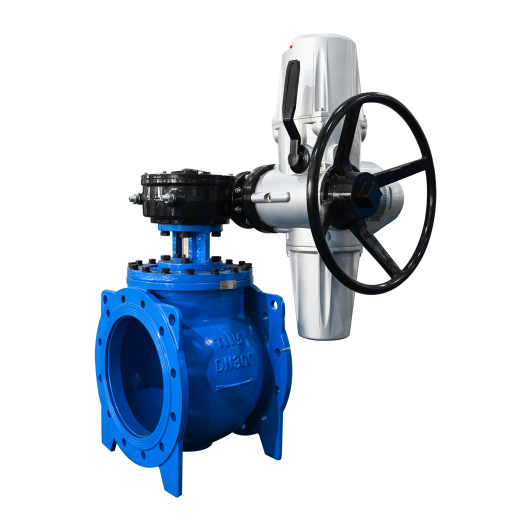3. Ball Valve
The ball valve evolved from the plug valve. Its opening and closing part is a sphere, and the sphere rotates 90°around the axis of the valve stem to achieve the purpose of opening and closing. The ball valve is mainly used on pipelines to cut off, distribute, and change the flow direction of the medium. A ball valve designed with a V-shaped opening also has a good flow regulation function.
TWS valve factory provide resilient seated wafer butterfly valve YD37A1X3-16Q, Double flanged concentric butterfly valve D34B1X3-16Q, Double flanged eccentric butterfly valve according to Ser.13 or series 14, BS5163/F4/F5 /ANSI CL150 rubber seated gate valve, Y-strainer, balancing valve, back flow preventer.
3.1 Advantages:
① It has the lowest flow resistance (practically 0).
② Since it will not get stuck during operation (in the absence of lubricant), it can be reliably applied to corrosive media and low-boiling-point liquids.
③ It can achieve complete sealing within a relatively large pressure and temperature range.
④ It can achieve quick opening and closing. The opening and closing time of some structures is only 0.05 to 0.1 seconds, ensuring that it can be used in the automated systems of test benches. When opening and closing the valve quickly, there is no impact during operation.
⑤ The spherical closing part can automatically position at the boundary position.
⑥-- The working medium is reliably sealed on the valve.
Q⑦ When the valve is fully open and fully closed, the sealing surfaces of the sphere and the valve seat are isolated from the medium. Therefore, the medium flowing through the valve at high speed will not cause erosion of the sealing surfaces.
⑧ It has a compact structure and light weight. It can be considered the most reasonable valve structure for low-temperature medium systems.
⑨ The valve body is symmetrical. Especially for the welded valve body structure, it can well withstand the stress from the pipeline.
⑩ The closing part can withstand the high pressure difference during closing.
⑪ The ball valve with a fully welded valve body can be directly buried underground, protecting the internal components of the valve from corrosion. Its maximum service life can reach 30 years, making it the most ideal valve for oil and natural gas pipelines.
3.2 Disadvantages:
① The main valve seat sealing ring material of the ball valve is polytetrafluoroethylene (PTFE). It is inert to almost all chemical substances and has comprehensive characteristics such as a small friction coefficient, stable performance, resistance to aging, a wide applicable temperature range, and excellent sealing performance. However, the physical properties of PTFE, including a relatively high coefficient of expansion, sensitivity to cold flow, and poor thermal conductivity, require that the design of the valve seat seal must be carried out around these properties. Therefore, when the sealing material hardens, the reliability of the seal is compromised. Moreover, the temperature resistance grade of PTFE is relatively low, and it can only be used at temperatures below 180°C. When the temperature exceeds this value, the sealing material will age. Considering long-term use, it is generally only used at 120°C.
② Its regulation performance is somewhat worse than that of the globe valve, especially for pneumatic valves (or electric valves.
5. Plug Valve
A plug valve refers to a rotary valve in which the closing part is in the shape of a plunger. By rotating 90°, the passage opening on the plug is made to communicate with or separated from the passage opening on the valve body, achieving the opening or closing of the valve. It is also called a cock, stopcock, or rotary gate. The shape of the plug can be cylindrical or conical. There are many types of it, including straight-through type, three-way type, and four-way type. Its principle is basically similar to that of a ball valve.
5.1 Advantages:
① It is suitable for frequent operation, with quick and light opening and closing.
② The fluid resistance is small.
③ It has a simple structure, relatively small volume, light weight, and is easy to maintain.
④ It has good sealing performance.
⑤ Not restricted by the installation direction, the flow direction of the medium can be arbitrary.
⑥ There is no vibration, and the noise is low.
5.2 Disadvantages:
⑦ The sealing surface is too large, resulting in too much torque and insufficient flexibility.
⑧ Affected by its own weight, the size of the valve diameter is limited.
In actual use, if a large-sized valve is needed, a reverse plug structure must be used, which is likely to affect the sealing effect.
More details, can be free to contact TWS valve factory.
Post time: Apr-12-2025





